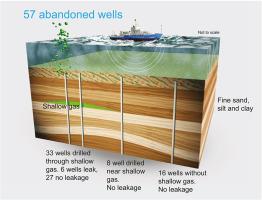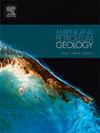荷兰北海废弃水井的甲烷泄漏
IF 3.7
2区 地球科学
Q1 GEOSCIENCES, MULTIDISCIPLINARY
引用次数: 0
摘要
甲烷是一种强大的温室气体,也是因人为添加气体而导致全球变暖的第二大温室气体。目前,全球温室气体清单没有考虑到海洋排放的甲烷。北海是一个石油和天然气开采密集的海域,最近有人认为它是人为甲烷排放的主要来源。所有通过浅层天然气(甲烷)钻探的油井都被发现泄漏,所有废弃油井的三分之一被发现是通过浅层天然气钻探的。在此,我们介绍了荷兰北海浅层天然气废弃井甲烷泄漏调查的结果。我们调查了 57 口废弃油井,其中 33 口是钻过浅层天然气的。九个地点出现了气泡羽流(声学照明弹)。我们注意到废弃油井的气体泄漏与天然气渗漏点之间存在明显差异。油井漏气的特点是井口有一到两个气泡羽流,周围没有气泡羽流,而天然气羽流区的特点是有几十到几百个气泡羽流,井口没有气泡羽流。在六口井中,我们得出的结论是,羽流是由油井泄漏浅层天然气造成的,而观测到的三个羽流场则被归类为自然渗流。我们发现,18% 的钻过浅层天然气的油井发生了泄漏,11% 的废弃油井钻过浅层天然气。当我们对样本中过多的浅层天然气井(58% 的样本钻探的是浅层天然气)进行补偿后,我们发现荷兰北海所有废弃油井中只有不到 2% 的油井可能发生了泄漏。油井泄漏似乎发生在存在大量浅层天然气且废弃油井明显存在完整性问题的情况下。本文章由计算机程序翻译,如有差异,请以英文原文为准。

Methane leakage from abandoned wells in the Dutch North Sea
Methane is a powerful greenhouse gas and the second most important when considering global warming due to anthropogenic added gasses. Global inventories of greenhouse gasses currently do not take into consideration methane emitted from the ocean and seas. The North Sea is an intensely exploited seas for oil and gas and it was recently suggested to be a major source for manmade methane emissions. All wells drilled through shallow gas (methane) were found to be leaking and one-third of all abandoned wells was found to be drilled through shallow gas. Here we present the results from a research expedition to investigate methane leakage at abandoned wells drilled through shallow gas in the Dutch North Sea. We surveyed 57 abandoned wells of which 33 were drilled through shallow gas. Nine locations showed bubble plumes (acoustic flares). We noted a distinct difference between gas leakage of abandoned wells and locations with natural gas seepage. Whereas well leakage consists of one or two bubble plumes at the wellhead itself and no bubble plumes in the surrounding area, natural plume fields are characterized by tens to hundreds of plumes and none at the wellhead. At six wells, we conclude that the plumes are caused by the well leaking shallow gas, whereas three observed plume fields classify as natural seepage. We found that 18% of wells drilled through shallow gas were leaking, with 11% of all abandoned wells being drilled through shallow gas. When we compensated for over-representation of shallow gas wells in our sample (58% of our sample is drilled through shallow gas), we find that less than 2% of all abandoned wells in the Dutch North Sea is likely leaking. Well leakage seems to occur when large quantities of shallow gas are present and the abandoned well apparently suffers from an integrity issue.
求助全文
通过发布文献求助,成功后即可免费获取论文全文。
去求助
来源期刊

Marine and Petroleum Geology
地学-地球科学综合
CiteScore
8.80
自引率
14.30%
发文量
475
审稿时长
63 days
期刊介绍:
Marine and Petroleum Geology is the pre-eminent international forum for the exchange of multidisciplinary concepts, interpretations and techniques for all concerned with marine and petroleum geology in industry, government and academia. Rapid bimonthly publication allows early communications of papers or short communications to the geoscience community.
Marine and Petroleum Geology is essential reading for geologists, geophysicists and explorationists in industry, government and academia working in the following areas: marine geology; basin analysis and evaluation; organic geochemistry; reserve/resource estimation; seismic stratigraphy; thermal models of basic evolution; sedimentary geology; continental margins; geophysical interpretation; structural geology/tectonics; formation evaluation techniques; well logging.
 求助内容:
求助内容: 应助结果提醒方式:
应助结果提醒方式:


